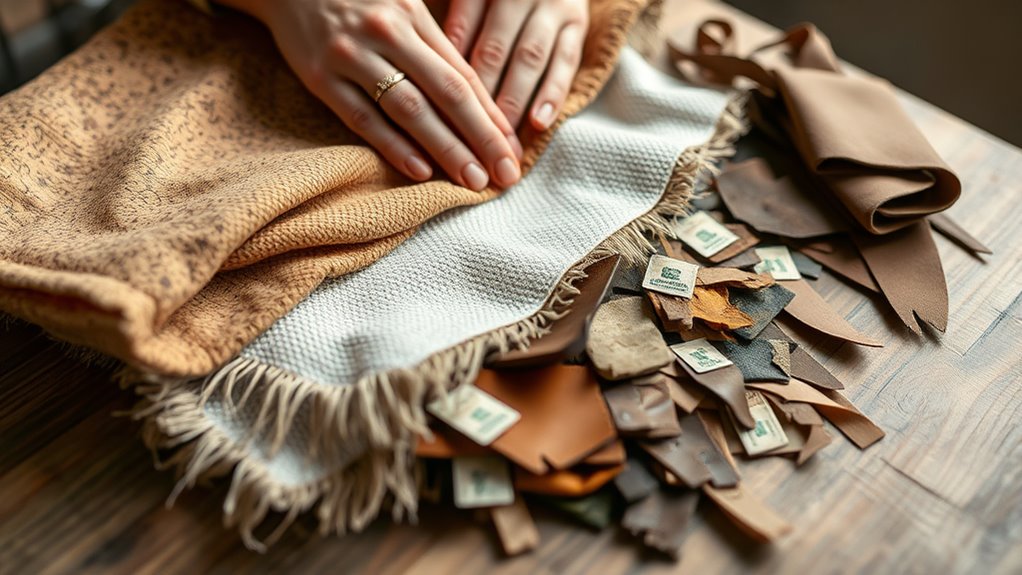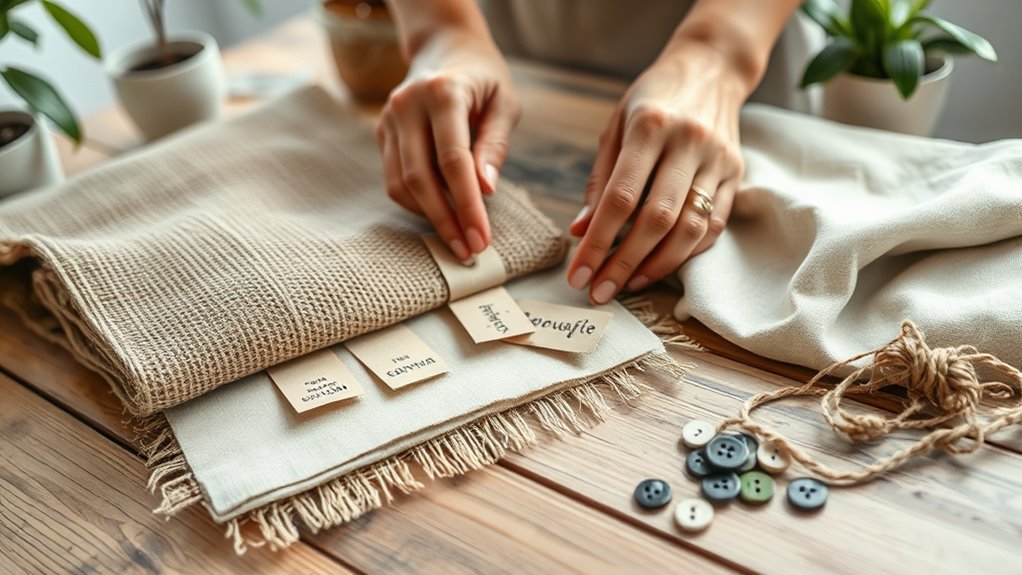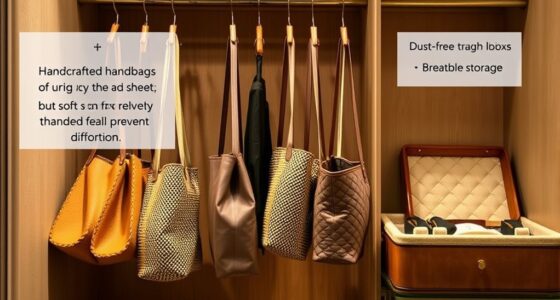To choose sustainable materials for DIY bags, focus on eco-friendly fabrics like recycled polyester, organic cotton, hemp, or bamboo, which grow quickly without harmful chemicals. Look for certifications such as GOTS or OEKO-TEX to guarantee eco-conscious production. Repurposing old textiles or using recycled fibers reduces waste and carbon footprint. Consider the entire life cycle of your materials, including biodegradability, to make environmentally responsible choices. Keep exploring to discover how these options can elevate your eco-friendly craft projects.
Key Takeaways
- Opt for fabrics certified organic or from renewable sources like GOTS, OEKO-TEX, or Fair Trade.
- Choose recycled materials such as recycled polyester, nylon, or reclaimed textiles to reduce waste.
- Prioritize biodegradable natural fibers like hemp, organic cotton, or bamboo for end-of-life sustainability.
- Incorporate upcycled textiles from old garments or scraps to minimize environmental impact and add a unique touch.
- Consider the entire life cycle of materials, including production, durability, and biodegradability, to ensure overall eco-friendliness.

As more people become aware of environmental impacts, choosing sustainable materials has never been more important. When you’re making DIY bags, your choices can considerably reduce waste and lessen your carbon footprint. One of the first steps is exploring recycling options, which can provide you with unique, eco-friendly fabrics that are both stylish and sustainable. Recycled fabrics, like those made from plastic bottles or reclaimed textiles, offer a great way to give new life to materials that would otherwise end up in landfills. You might find recycled polyester, nylon, or even fabric made from reclaimed cotton, all of which are excellent options for eco-conscious projects. These materials often have the added benefit of being durable and easy to work with, making them ideal for creating sturdy, long-lasting bags.
Incorporating eco-friendly fabrics into your DIY projects isn’t just about recycling; it’s also about choosing materials that are produced with minimal environmental impact. Look for fabrics that are certified organic or made from renewable resources, ensuring you’re supporting sustainable farming and manufacturing practices. Organic cotton, hemp, and bamboo are popular choices because they grow quickly without pesticides or synthetic fertilizers, reducing pollution and conserving water. When selecting fabrics, check for certifications like GOTS (Global Organic Textile Standard) or OEKO-TEX, which guarantee that the materials meet strict environmental and social standards. This way, you’re not just making a bag; you’re making a statement about caring for the planet.
Another aspect to consider is how you handle your fabric scraps and leftover materials. Recycling options extend beyond buying recycled fabrics—think about repurposing or upcycling old garments, curtains, or other textiles to create unique, personalized bags. This approach minimizes waste and adds a distinctive touch to your designs. You can also explore local thrift stores or textile recycling programs in your community, which often accept fabric donations or scraps suitable for craft projects. By doing so, you participate in a circular economy, helping reduce textile waste and promoting sustainability.
Finally, when choosing your materials, think about their life cycle and biodegradability. Eco-friendly fabrics tend to break down more naturally once disposed of, reducing environmental harm. Combining recycled options with natural, biodegradable fabrics ensures your DIY bags are as sustainable as possible from start to finish. Making informed choices about your materials not only results in beautiful, functional bags but also supports a healthier planet. Your efforts in selecting eco-conscious fabrics and recycling options demonstrate that crafting can be both creative and environmentally responsible.
Frequently Asked Questions
Are Synthetic Materials Eco-Friendly for DIY Bags?
Synthetic materials can be eco-friendly for DIY bags if you consider their biodegradability benefits and recycling options. While some synthetics aren’t biodegradable, others are designed to break down more easily, reducing environmental impact. Recycling synthetic materials also helps minimize waste. By choosing recycled or biodegradable options, you support sustainability and create bags that are more eco-friendly, making synthetic materials a better choice when carefully selected.
How Do I Assess the Durability of Sustainable Fabrics?
Your DIY bag’s durability depends on how well you assess its fabrics. Focus on fabric weight—heavier fabrics tend to be stronger—and test tear strength, which shows how much force it can withstand. Feel the fabric’s thickness and check for reinforced seams. By paying attention to these factors, you can guarantee your bag survives even the wildest adventures, making it an unstoppable, eco-friendly masterpiece that lasts a lifetime.
Can Upcycled Materials Be as Stylish as New Ones?
Yes, upcycled materials can be just as stylish as new ones. You can follow current recycling trends to create unique, eye-catching fashion statements with your DIY bags. By choosing vibrant fabrics and innovative designs, you showcase your style while promoting sustainability. Upcycling allows you to express your creativity, making each bag one-of-a-kind, and proves that eco-friendly choices can be trendy and fashionable.
What Certifications Indicate Genuine Sustainable Materials?
You can identify genuine sustainable materials by checking certification standards like GOTS for organic textiles or Fair Trade for ethical sourcing. An eco label’s meaning signals that the material meets specific environmental and social criteria, ensuring authenticity. Always look for reputable certifications on labels or product descriptions, as they confirm the material’s eco-friendly status and help you make responsible choices when creating your DIY bags.
How Do Price Points Compare Between Sustainable and Conventional Fabrics?
You might think sustainable fabrics are pricier, but that’s not always true. The cost comparison varies; some eco-friendly materials cost more upfront, reflecting their quality and ethics, while others are surprisingly affordable. An affordability analysis shows you can find sustainable options that fit your budget, proving you don’t need to sacrifice style or conscience for cost. So, don’t let price be your only guide—sometimes, you get more than you pay for.
Conclusion
Now, as you hold your custom bag, imagine it’s woven from the earth’s gentle embrace—bamboo shoots swaying in the breeze or recycled fabrics blending seamlessly. Your choice of sustainable materials not only crafts a unique piece but also nurtures the planet’s vibrant tapestry. With each stitch, you’re weaving hope and responsibility into something beautiful, creating a future where fashion and nature walk hand in hand. Your mindful creation becomes a symbol of change, glowing softly like dawn’s first light.









